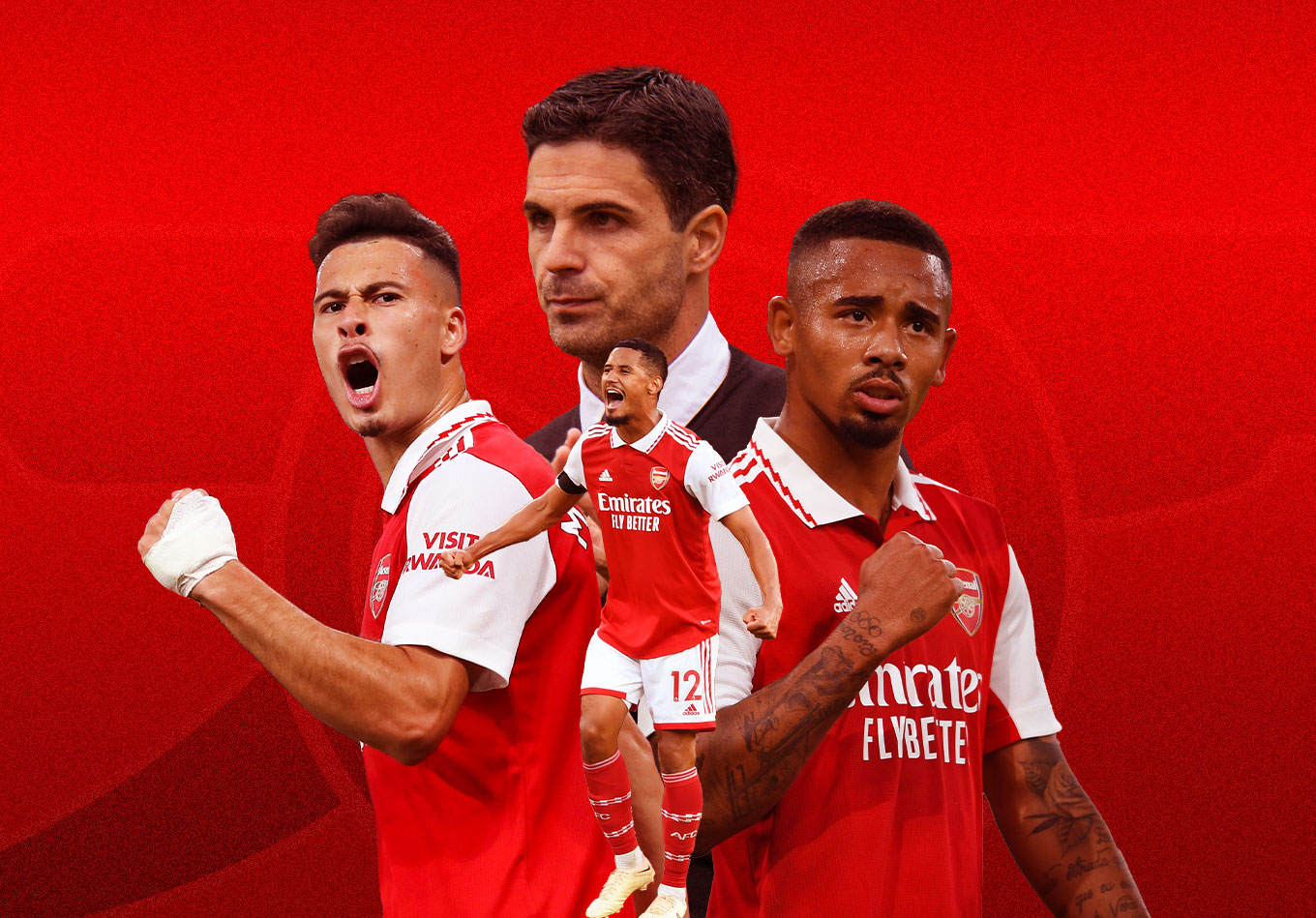If there’s one club whose good form you might not trust in recent years, whose neat triangles and pretty floral arrangements make you suspicious, it’s Arsenal.
It’s a scepticism well earned two-and-a-half years into a project of false dawns and nearly two decades into a delicate period in the club’s history. The rest of the world might have caught up with Arsène Wenger’s mid-noughties aesthetic, but when that familiar timidity takes over Arsenal are still the ones we accuse of always trying to walk the ball in.
Yet there is a lot about their table-topping start to the 2022-23 season that looks and feels different, no matter how fair or unfair the accusation that Arsenal’s fixtures have been easy. Their wins so far have been defined by a swagger and a tactical precision that suggests Mikel Arteta finally has the squad he needs to enact the menacing, surgical, dead-eyed football taught to him by his mentor Pep Guardiola.
Since Arteta’s appointment in December 2019, we have seen lots of variations from the Guardiola model, from formation tweaks to improvisational attacks, but with the benefit of hindsight, almost all of these iterations were nothing more than reactive problem-solving until Arteta had the right players to go full Pep.
Positioning, Possession, and Pressing Perfection
Arsenal’s passing is dictated by extremely detailed coaching that tells the players exactly where to position themselves and when to move, with the pitch demarcated into zones and the overall shape endlessly, immaculately formed to create triangles all over the pitch. The idea is to play rondos from back to front – and it finally seems to be working thanks to an excellent summer window.
Oleksandr Zinchenko and Gabriel Jesus have brought years of Guardiola training from their time at Manchester City and have immediately settled, the former dictating play as an interior full-back with the latter injecting an urgency and forward momentum into Arsenal’s play.
Jesus has received 65 progressive passes this season, more than any other player in the Premier League, reflecting his movement as the new orchestrator from the top – and changing Arsenal from a team of stale possession, which quickly disintegrates, into a team with depth and purpose; a wall pass to keep the rondos going and a dribbler (38 so far, the most in the Premier League) to boot.

These two are assisted by Thomas Partey’s upturn in form as the anchor and metronome. Arsenal now rank sixth for ball recoveries, up from 17th last season, while the Ghanian tops their charts for tackles with 2.6 per 90. Partey’s solidity frees up Granit Xhaka to focus on his superb distribution and releases Martin Ødegaard to dictate the tempo from a higher starting position. The Norwegian is full of creative guile, but also averages 2.0 possessions won in the final third per game, the fifth most in the division.
The combined effect has been to make Arsenal far more considered and consistent both in and out of possession, creating measured passing that revolves around the width and depth of the field. As reflected in their numbers this year compared to last, Arteta’s side have dramatically improved on a number of possession and passing metrics:
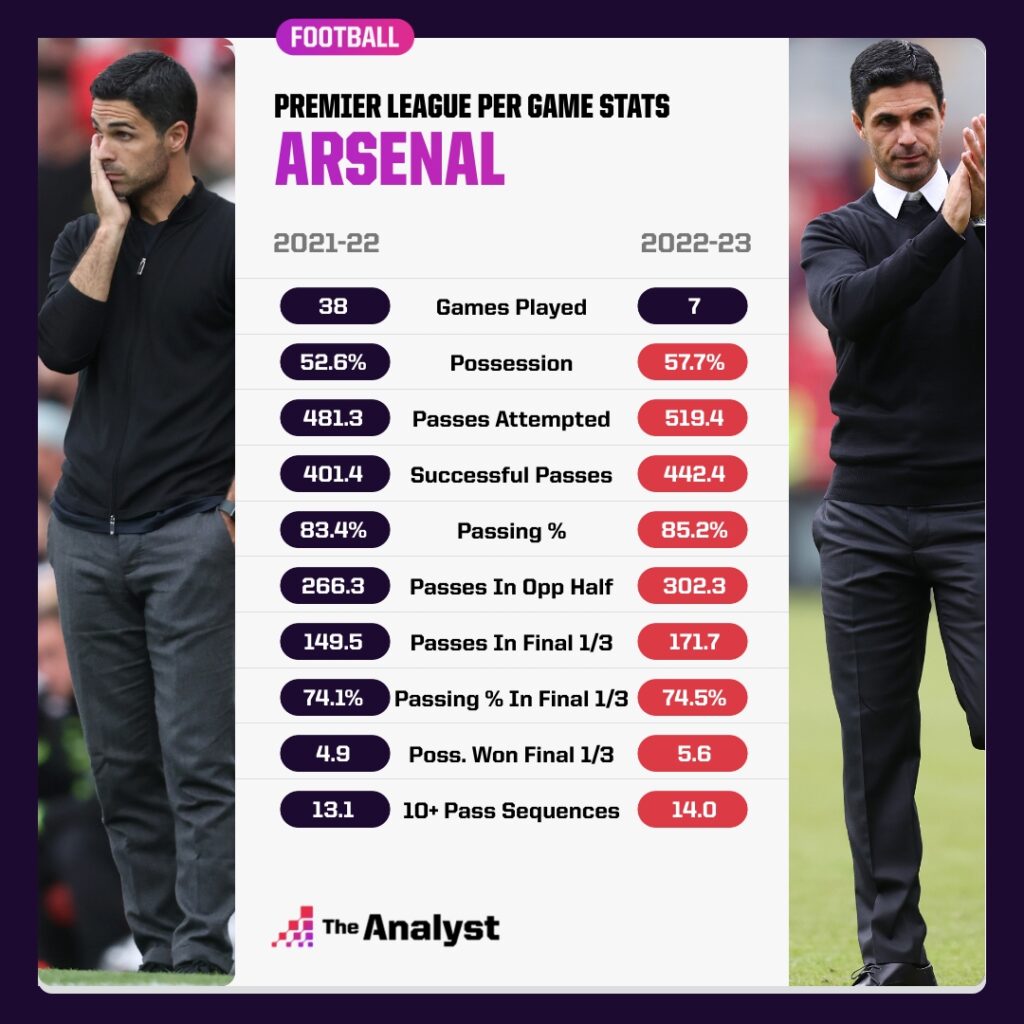
And while Arsenal’s pressing is middling compared to other Premier League clubs in 2022-23, they are highly efficient with it, ranking fourth for high turnovers (61) and first for shot-ending high turnovers (13) – despite sitting 12th in the table for overall pressed sequences (86).
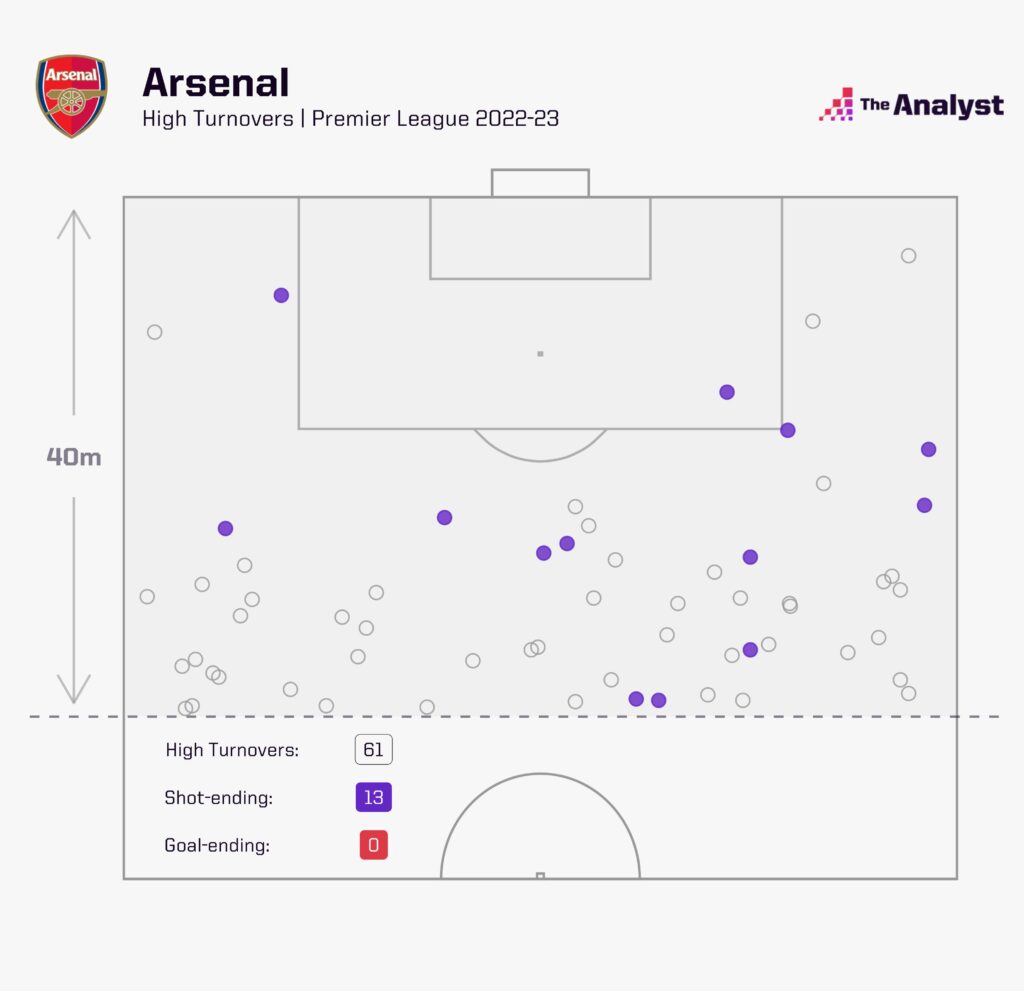
One stat neatly captures how this targeted and adept pressing links with Arsenal’s possession control; they top the charts (with 23) for shot-ending possession starts, which measures when a player wins back possession to begin a passing sequence that ends in a shot.
Counters and Set-Pieces Are the Hidden Plus Points
So far so Guardiola, but there is one way in which Arsenal are distinct from Manchester City. Arteta is more tolerant of counter-attacks and a more direct, vertical method of attack when suitable. This is largely the result of his squad possessing more straight-lined players than Guardiola’s, notably in Bukayo Saka and Emile Smith Rowe, although he has also made a tactical choice to instruct his centre-backs to break the lines.
Gabriel Magalhães and William Saliba have forged a strong defensive partnership – the stability of which is no doubt contributing to Arsenal’s calm consistency in the rest of their play – and are unusually good at carrying the ball out of defence.
Both rank in the Premier League top five for total carries so far this season while Saliba topped the charts across Europe at Marseille in 2021-22.
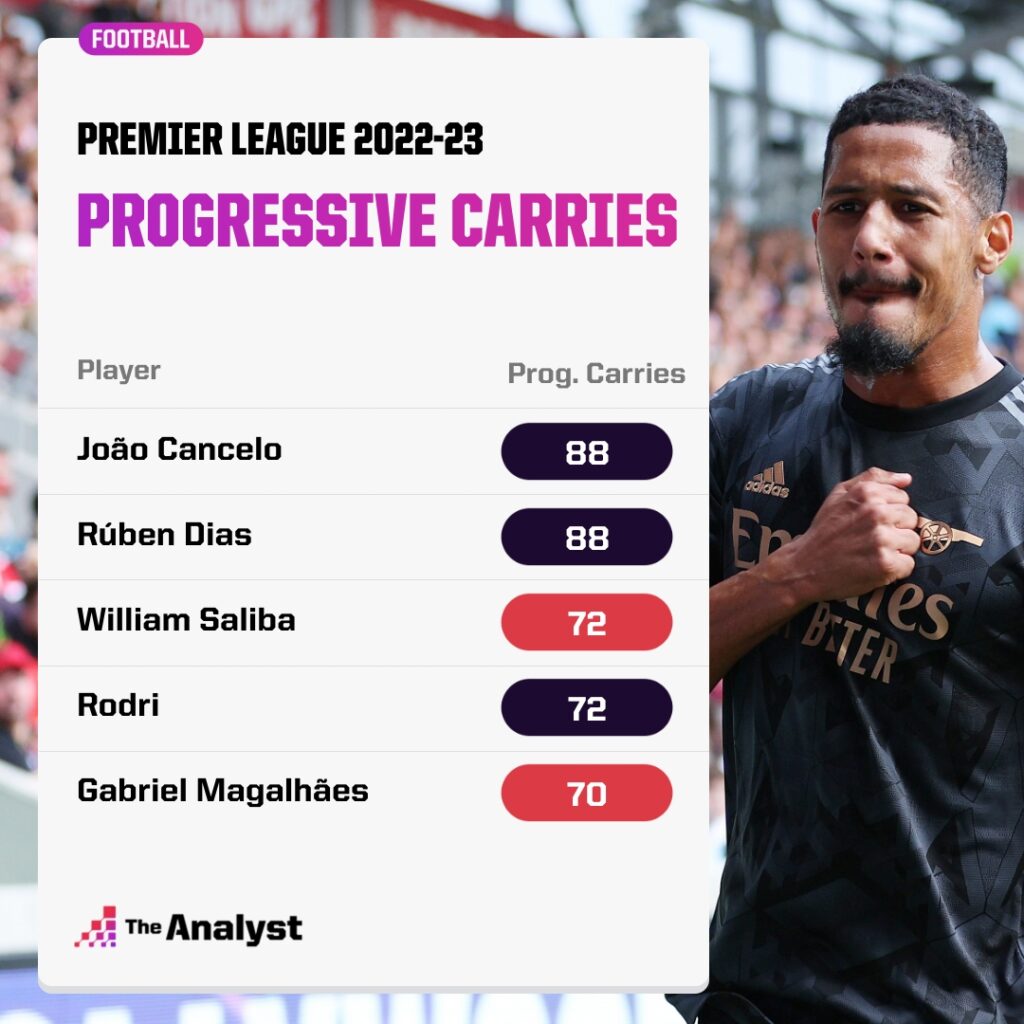
This is indicative of Arsenal’s willingness to pick their moments and surge forward on the break or in the transition. They sit third in the Premier League for total dribbles attempted this season with 139, just below Southampton and Wolverhampton Wanderers, thanks to the penetrative work of Jesus (38), Saka (25), and Gabriel Martinelli (25). Most telling of all, Arsenal are fourth in the league for ‘direct attacks’ with 14, behind only Wolves, Fulham, and Tottenham Hotspur.
The second surprising plus point from Arsenal this season is their focus on set-pieces. Their 4.40 xG from set-pieces is the highest in the league; their 0.95 xG conceded is the third best; and they have scored five set-piece goals, the joint-most.
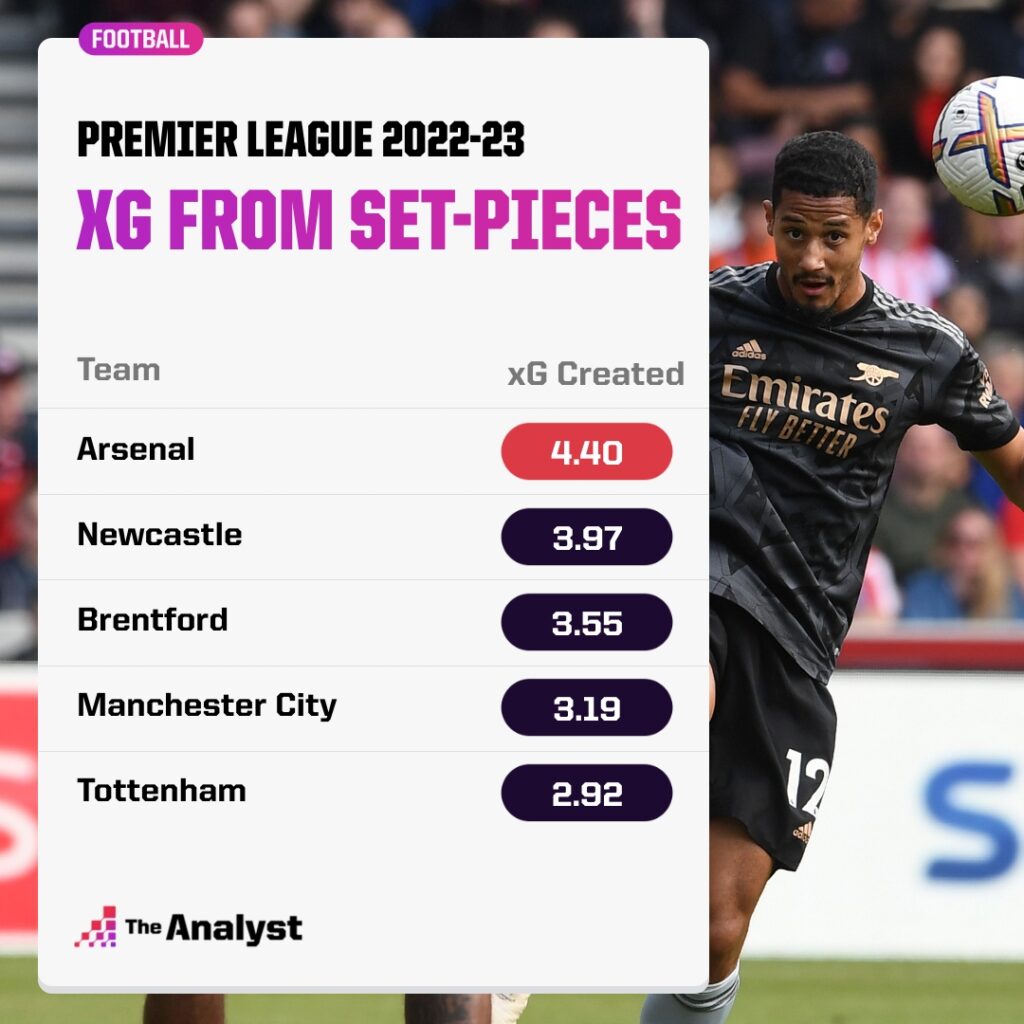
Their inswinging corners caused havoc last season, and it’s a tactic they are clearly still employing this year, with every single one of their deliveries into the box being a whipped inswinger.
Manchester United Defeat Reveals Potential Flaws
Clearly Arsenal have turned a corner, but it isn’t all good news, and in fact Arsenal’s harshest critics would argue they were roundly beaten against their only tricky opponents so far in 2022-23, when Erik ten Hag’s Manchester United uncovered a way to neutralise Arteta’s possession football.
In flashes, it was a very Ten Hag-like performance of intricate passing mixed with bursts of direct line-breaking passes as the deep-lying Christian Eriksen cut balls through to Bruno Fernandes. But for the most part, United sat off like an Ole Gunnar Solskjær team, limiting Arsenal’s capacity to move beyond their opponents with their triangles or in the dribble.
In the 3-1 defeat Arsenal were faced with their highest PPDA of the season (17.7) and fewest pressed sequences (3), but tellingly recorded their highest ‘direct speed’ of the season, moving the ball upfield at 1.73 metres per second, more than twice that recorded against Brentford last weekend (0.79). They also hit a season-high number of open-play crosses (13) despite having, on average, the fewest number of players in the opposition box this season (2.8). Put together, this tells the story of a more fearful Arsenal unable to commit numbers but also, facing less opposition pressure, unable to find their rhythm building gradually through the lines.
The United game was one of just two occasions that Arsenal have trailed in matches this season, and how they deal with adversity is something that will surely be tested in October.
Lack of Squad Depth the Biggest Issue
Perhaps the United performance was a one-off that reflected Ten Hag’s growing influence more than it did Arsenal’s deficiencies. But even if that is the case, it is noteworthy that two of the United goals were the direct consequence of positional errors from Albert Sambi Lokonga, who found it difficult to deputise for Partey.
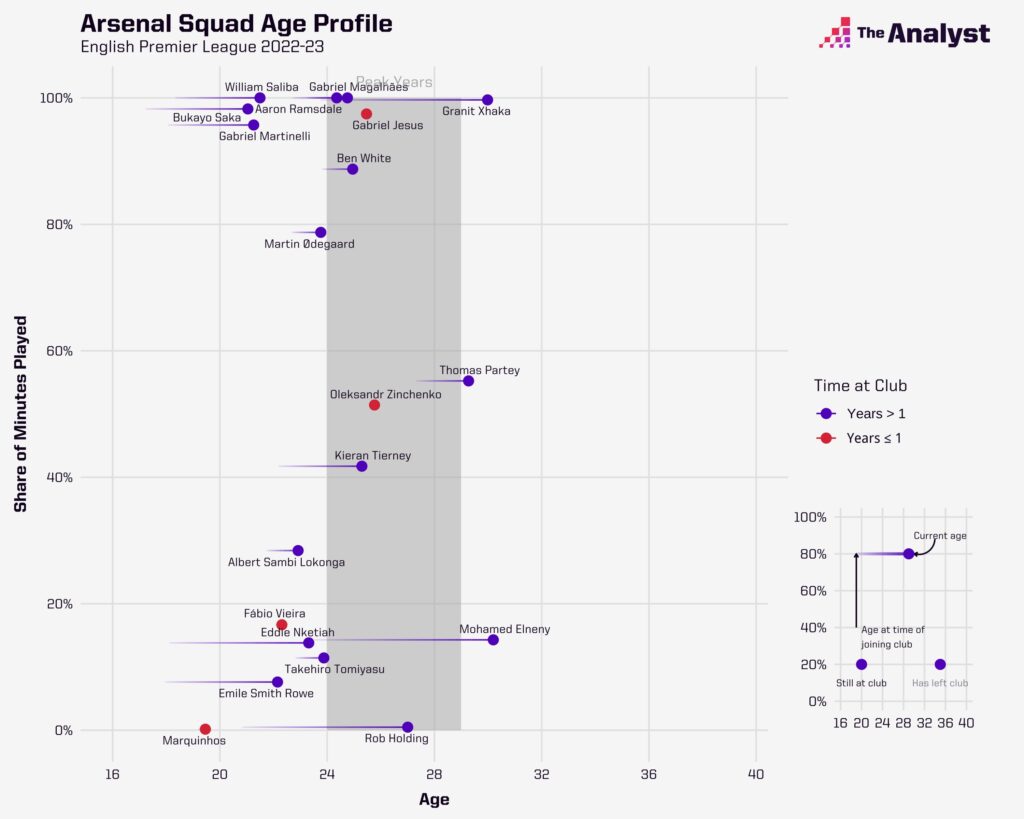
It was the first sign that Arsenal’s squad just isn’t deep enough to cope with the demands of this particularly exhausting season. Even against Brentford there were signs of this problem, with a substitute bench consisting of the likes of Matt Smith, Lino Sousa, Rob Holding, Matt Turner, and Ethan Nwaneri looking very weak. While it’s a great story, it isn’t a sign of a deep squad for a 15-year-old to get minutes.
But Arsenal don’t need a title challenge for this to be a successful season. A place in next year’s Champions League, and some silverware in Europe, is definitely on the cards for a team – and a manager – finally coming together as Guardiola replicas.
Enjoy this? Subscribe to our newsletter to receive five stories each Friday.
